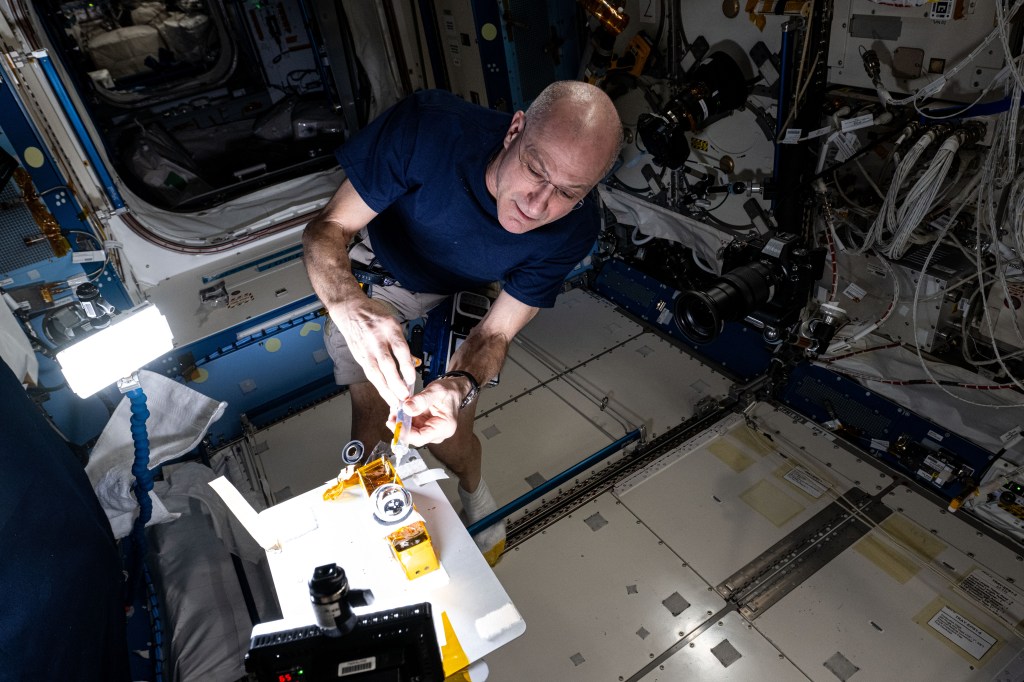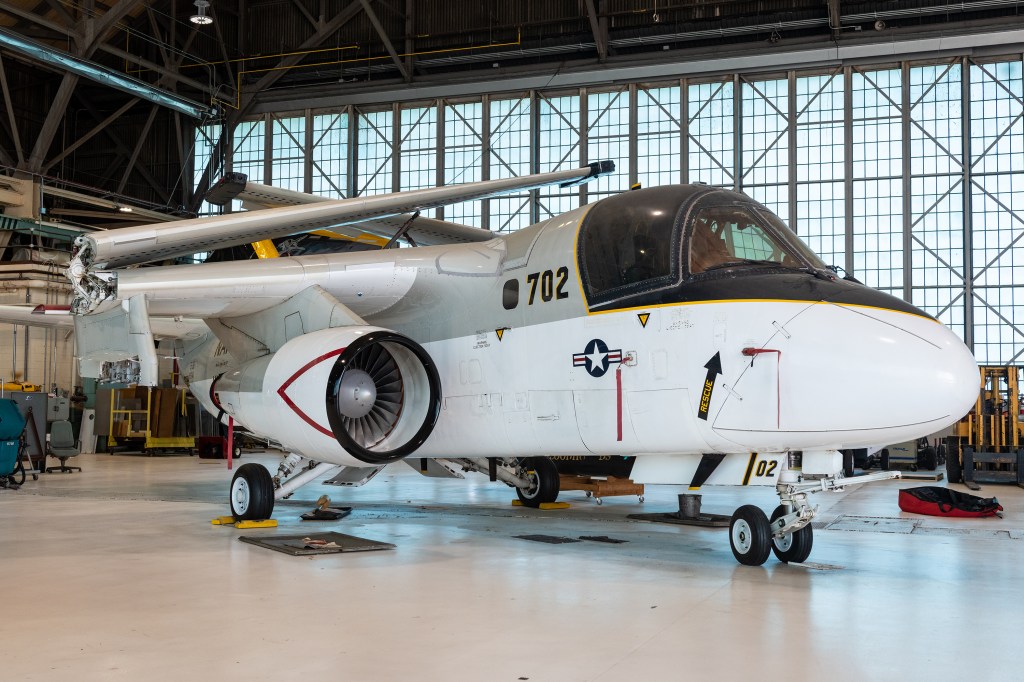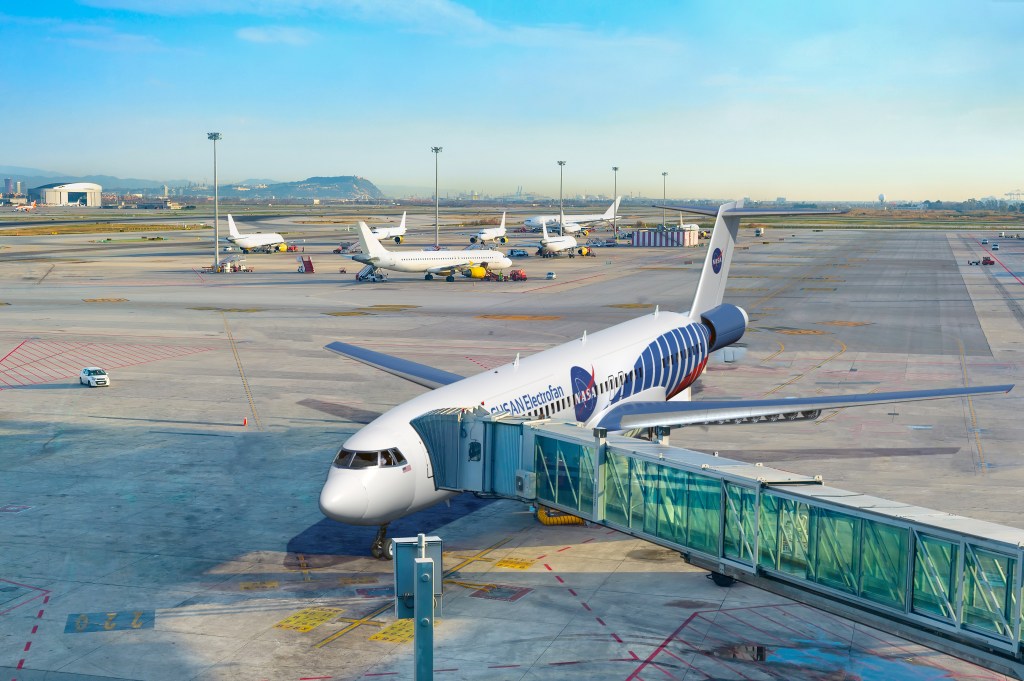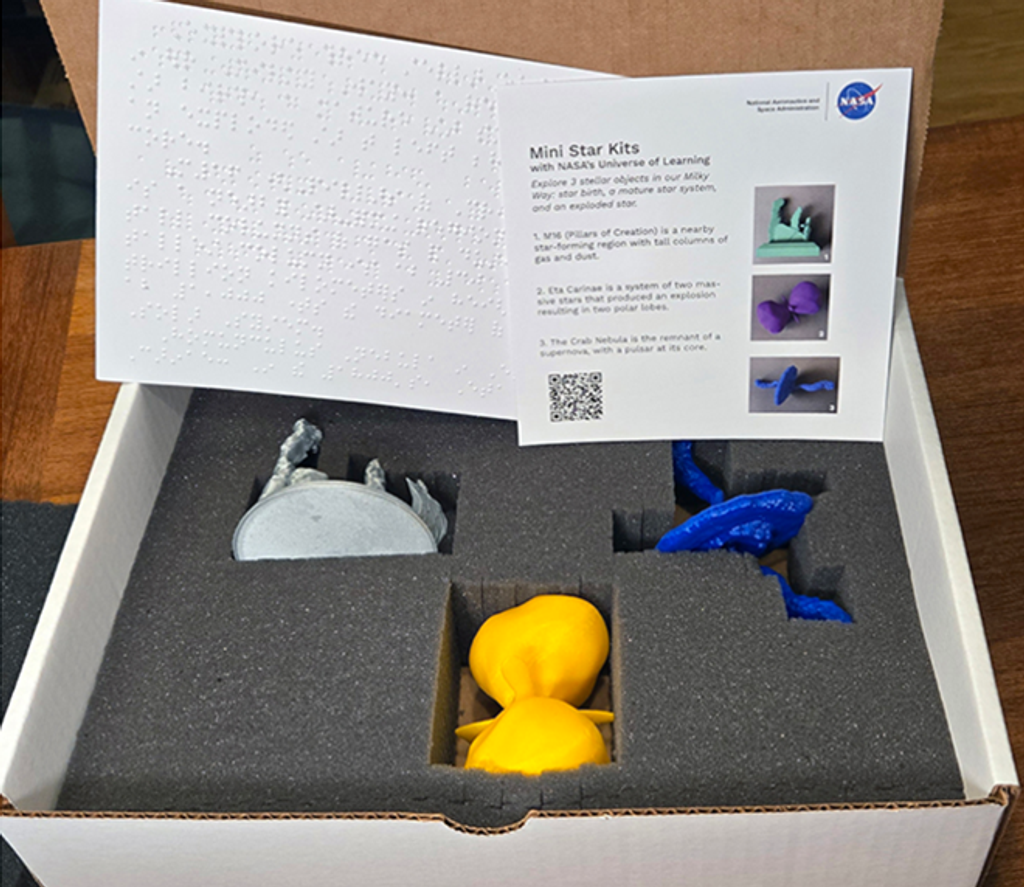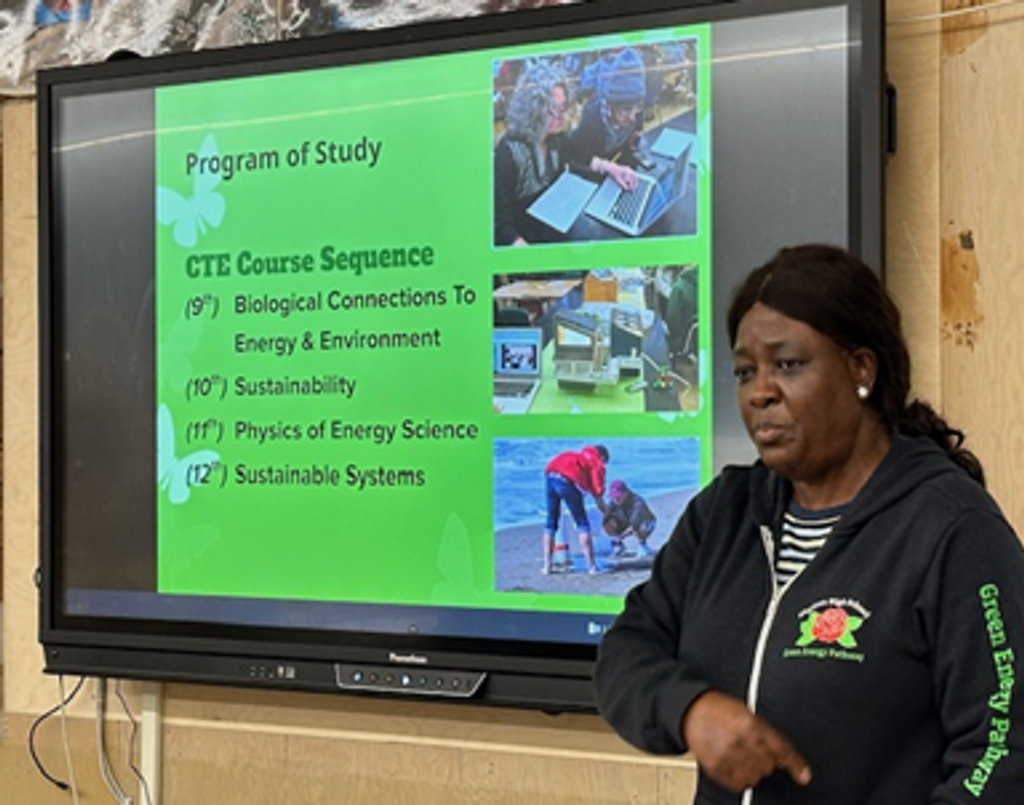
From Earth orbit to the Moon and Mars, explore the world of human spaceflight with NASA each week on the official podcast of the Johnson Space Center in Houston, Texas. Listen to in-depth conversations with the astronauts, scientists and engineers who make it possible.
On episode 365, Johnson Space Center’s Chief Technologist discusses how Johnson and White Sands Test Facility are opening their Front Doors to those interested in exploring opportunities, capabilities, technology and data available to different organizations. This episode was recorded on November 1, 2024.

Transcript
Dane Turner: Houston, we have a podcast! Welcome to the official podcast of the NASA Johnson Space Center. I’m Dane Turner, and I’ll be kicking off this episode today. On this podcast, we bring in the experts, scientists, engineers, and astronauts, all to let you know what’s going on in the world of human spaceflight and more. And once again, we are happy to be welcoming another talented individual lending their voice as a host of this podcast, Nilufar Ramji. Welcome.
Nilufar Ramji: Hey, Dane, thanks so much for having me.
Dane Turner: So Nilufar, what do you do here at NASA?
Nilufar Ramji: Well, I’m really happy that you asked that. I am actually the person that is responsible to lead a team of public affairs officers for all of our Exploration and Development Program. So you hear Moon to Mars across NASA, and that’s really what our area focuses on. It focuses on programs like Artemis, it focuses on spacesuits tools, rovers, Commercial Lunar Payload Services, engineering, moon rocks, you name it. It probably falls under my area if it’s going to the Moon, Mars or beyond.
Dane Turner: You cover a lot of things here you had a whole life in another part of the world. What did you do?
Nilufar Ramji: Yeah, so I actually spent a little part of my career living and working in East Africa doing communications for a nonprofit. So the job was to look at the development work that was taking place in East Africa to demonstrate to areas like Europe and North America the different projects that are impacting individuals and how aid dollars were helping them. So just storytelling from a different perspective in health, rural development, and education.
Dane Turner: That is incredible. You’ve had all sorts of experience and you’ve got a background in program management, is that right?
Nilufar Ramji: Yeah, I actually wanted to go into program management for international development and fell into a communications job in international development. And I found my spark in some ways. So I never looked back, but it’s been a fabulous experience leading up to today.
Dane Turner: Incredible. And that is going to bring so much to the podcast. I’m really looking forward to all of the interviews that you’ve got coming up. So are you ready to get started?
Nilufar Ramji: Let’s jump right in.
Dane Turner: Take it away.
Host (Nilufar Ramji): Houston, we have a podcast! Welcome to the official podcast of NASA’s Johnson Space Center, Episode 365 “Johnson’s Front Door.” I’m Nilufar Ramji and I’ll be your host today. On this podcast, we bring in the experts, scientists, engineers, and astronauts, all to let you know what’s going on in the world of human spaceflight and beyond. As NASA prepares to travel further than we have before through the Artemis campaign, there will continue to be opportunities to collaborate with commercial space companies, students, and the public. Here at the Johnson Space Center, there are multiple facilities and opportunities that can leverage so much institutional knowledge by providing a path to successfully engage with NASA. Johnson Space Center will continue to grow as the hub of human spaceflight, and that’s where we open the Front Door of NASA’s Johnson Space Center and White Sands Test Facility. The Front Door was established in recent years to tackle this next chapter of our exploration journey. Whether folks represent industry, government, academia, or the general public, they can take a virtual step inside Johnson and explore the opportunities, capabilities, technology and data available to different organizations. So how does this even work? How can someone connect with the Front Door? Nick Skytland, chief technologist and director of the Business Development and Technology Integration Office at NASA Johnson Space Center is the person here to guide us through this added capability. Let’s jump right in.
[Music]
Host: Nick, thank you so much for coming on Houston We Have a Podcast today.
Nick Skytland: Thanks for having me.
Host: Tell us about yourself. What was your path to NASA? How did you get here?
Nick Skytland: Well, I am super excited to be here and I was super excited to get that offer letter from NASA way back in the day. I’m older now, but it all started actually in kindergarten for me. So my teacher rolled in this TV. It was probably black and white. I mean, I’m, you know, it’s been a while. And we watched a space shuttle launch. Unfortunately, it was the Challenger accident, but that moment inspired me for space exploration. So, you know, pursued engineering in the university setting and found my way to NASA as part of our Pathways program, our co-op program back then. And had an opportunity to come to Houston and loved it from day one. And I remember that day that I got the offer letter from NASA and it was December 20. And I said, “Great, how fast can I start?” And they said, “Well, I mean, we’re leaving for the holidays. So I mean, technically Jan. 6, it’s a Monday, that’s the next kind of period we’ll be back.” I said, “Great, I’ll be there at 8:00 a.m. Jan. 6.” And I packed everything up. I didn’t wait for anyone to come move me or anything. I packed everything up. I drove across the country and started my career at NASA. And my career at NASA has been quite a journey.
So I started in flight operations, training astronauts for spacewalk in the world’s largest pool, the Neutral Buoyancy Laboratory. And then I worked on human physiology as part of the Human Research Program, thinking about how we navigate the lunar surface and how we do that in spacesuits and lunar rovers, and how we ingress and egress out of these pressurized systems in a way that’s safe for the humans. And then I actually took a detour and I went to Headquarters and I helped lead the Open Government and the Open Innovation efforts at the agency. And so we ushered in the idea of hackathons and mass collaborations and open data and open source software. Started the International Space Apps Challenge, which as we know has grown into this really amazing event of, you know, 250 cities, 40,000 citizen scientists and technologists around the world contributing to the mission of space exploration. And then I spent some time doing talent strategy and engagement at Headquarters, thinking about how we retain our top talent. And then most recently I came back to Houston, to Johnson Space Center about six years ago in our exploration technology office. And that’s where I’ve been pretty much since then, although that’s turned into the chief technologist role in the Office of Business Development and Technology integration, which is a long way to say technology and partnerships.
Host: Very cool. And I was going to ask you about that next. You have two job titles, but tell me a little bit about the business development and technology integration office.
Nick Skytland: Well, regarding the two job titles, my wife tells me, I can’t say no. So to be fair, I do have two job titles, and they’re very big jobs. In fact, a couple years ago, our Center Director and center leadership really cast a vision for what the future of Johnson Space Center could look like. And partnerships was a big part of that. And technology is a big part of that. And so we recognize that we want to be better partners that we need to partner well with industry in this growing emerging space economy. And that NASA’s part of that economy is actually a small fraction, right? If you look at the economy being about $450 billion, our overall budget is, you know, $27 billion. The amount of money at Johnson Space Air for human spaceflight is a fraction of that. So maybe two and a half percent of the overall economy is related to human spaceflight. So how are you a leader in human spaceflight if you’re a small part of that economy? So we had to really rethink how we were doing things at Johnson Space Center. And so the vision cast was, hey, could we stand up a new organization that is really a front door for the center? And so I had the opportunity over the past couple years to stand that up to lead the office, and we focus on partnerships and technology. It’s all integrated together and innovation. So we have different functions from the pursuits to the formulation of agreements to the open innovation portfolio with our prizes and challenges to our $130 million technology portfolio for early stage investments, to finally the intellectual property portfolio of our patents and the licenses of those patents back to industry and the software agreements that we make available as well. So it’s a really exciting opportunity, really exciting job. We’re also very deeply involved in the strategy for this center, our Dare Unite Explore strategy for JSC.
Host: There’s so much to unpack there, but let’s talk a little bit about your other role that you can’t say no to, the chief technologist role before we get into all of the interesting things that you just described.
Nick Skytland: Yeah, it’s a really great position because I get a chance to meet with the other chief technologists across the agency. So each center has a chief technologist and a chief scientist. And so we get together and we oversee the technology investments that we make. And so of course, here at Johnson Space Center, we’re focused on human spaceflight and ushering in the future of that and extending human presence across the solar system. So what are the investments that we need to make from a technology standpoint, from rovers to spacesuits to entry, descent, and landing systems, to in situ resource utilization, to sensors, there’s nothing that’s too small of an investment, but it has to matter to the mission. We have to move the mission forward. And so we are focused on the earlier part of our TRL level, the technology readiness level, which is a really fancy one through 10 scale of helping advance technology development. So we focus on, you know, those earlier stages. And the intention is that we develop technology that matters to the missions that’s infused in the missions that, you know, makes it easier for us humans to live sustainably on the lunar surface and beyond. It’s pretty incredible. So, you know, things we think about, you know, what is the role of artificial intelligence in spacesuit design, right? You know, how do we mitigate the really pesky problem of dust on the lunar surface that gets in everything? It’s really annoying. And so how do we take advantage of the geniuses that we have working at NASA, but also in industry? How do we partner together to, you know, advance the frontiers of technology development? It’s a pretty great role.
Host: It really is. Okay, let me ask the question. I think everyone is thinking about high level, what is the Front Door?
Nick Skytland: Yeah. So the Front Door is a place that you can come and interact with NASA. And so I don’t know if you know, but it turns out that the government’s actually kind of hard to work with. Historically, again, apparently, we’ve not been the best partner, and so we want to fix that, right? We know that in an emerging space economy, in a thriving space industry, that all the boats rise together. NASA has a really important part to play in that economy, but so do all of our partners, and we have hundreds, if not thousands, of partners that we work with. And so we want to be a better partner to industry. We want to work at the speed of business. We want to work in a way that they’re familiar with, and that that goes for everything from the processes that we have to make sure that they are agile. And we can get a response to our industry partners when they have a question in a reasonable amount of time. But it also is simply just making our resources available. You know, we have a lot of really unique capabilities for human spaceflight that don’t exist anywhere else in the world. And so how can that benefit our industry partners who we have a common mission, right? Extend human presence across the solar system, and we rely on them to be successful for our own success. And so we want to simplify it for them. And so that’s the idea of a Front Door. You have how many front doors to your house? Only one, right? You don’t have a whole bunch of other ways to interact. I mean, you probably have a back door, right? And maybe you have a side door, your kids probably come in through the window once in a while, and it’s the same at NASA, right? But we really do want to have like a nice red painted front door where it’s like, hey, knock, knock, knock NASA. And then someone opens a front door and they have a smile on their face of like, hey, thanks for coming over. We’d love to come into my foyer. We’d love to explore what a potential collaboration could look like with you. What ideas do you have about the future of human space exploration? Let’s have a conversation about that. And then once that conversation turns into something that we agree we would like to do together, we can then really quickly put an agreement in place to go do that. Now, sometimes that’s a procurement, sometimes that’s a partnership. Sometimes that might just be helping them find what they’re looking for and point them in a different direction. But that’s the idea. That’s the idea of a front door, just like the front door of your house, right?
Host: So a one-stop-shop for all things NASA and human spaceflight.
Nick Skytland: Yeah. But not a choke point, right? We don’t want to be the only place, but we want to be a place that if you don’t know anywhere else to go, if you don’t know who to talk to about using one of our amazing chambers, or you don’t know who to talk to about this really brilliant idea you have for a new company that might help NASA meet a need, you know, you can come talk to us. And we’d, we’d love to, we’d love to explore that.
Host: So you hit on something really important. I wanted to get to what types of people or organizations can benefit from the Front Door.
Nick Skytland: Yeah. So there are a lot, I mean, pretty much everybody, I’ll just start there. So everyone from a citizen to a mature aerospace company or an adjacent company like oil and gas or healthcare or energy or, you know, whomever. So we have all of those types of relationships. So at the highest level, either government agencies, they might not know who to talk to at NASA, and you’d be surprised, right? But NASA can be a really big place, and you might not know who the dust mitigation expert is. And so you might knock on the front door of Johnson Space Center and say, hey, I’m with another government agency. I’d love to talk to you more about dust mitigation. Or it might be an industry partner. Maybe it’s a startup or maybe it’s an entrepreneur with an idea, or maybe it’s a venture capitalist who has funding and they’re trying to figure out where to make a good investment that would benefit the United States of America. And then I also point out the citizens, the citizen scientists, and the citizen technologists, which I believe are such an important part of a thriving economy, is, you know, we don’t have, you don’t have to be in an organization to do something. People start stuff in their garages all the time. So where do they go? Well, we have a whole portfolio of really interesting challenges that we put out there that citizens can respond to. And not only, you know, share an idea but possibly be compensated for that idea. And so that’s our, our solver community. And, and that’s all part of the front door.
Host: And so that means NASA’s not exploring alone. We’re exploring with many in different types of people and organizations.
Nick Skytland: That is really well said.
Host: Thank you. Thank you. You mentioned Dare Unite Explore really briefly, right at the top of our conversation. That’s sort of our development strategy where we’re headed as Johnson Space Center. So can you share with our listeners in a few sentences what Dare Unite Explore encompasses and what it’s all about?
Nick Skytland: Yeah. So Dare Unite Explore is our bold vision for the future of human space exploration. And what we’re doing about it at Johnson Space Center, it’s the commitments that we’re making to usher that in, right? So those words matter, dare unite, explore. And so we dare to push the limits of what’s possible, of what humans have done before. That’s the business of NASA, that’s the business of Johnson Space Center. We unite together, cause we know, again, we don’t do this alone. We know the value of partnerships in collaborations. So we choose to do that together, and that’s uniting. And we recognize the diversity of perspective and how invaluable that is when it comes to innovation. And finally, we explore new frontiers, and that might be new frontiers of human spaceflight, habitation systems on other planets. It might be a research or technology area, it might be an area of science, but it’s not just scientists and technology talk technologists that are exploring new frontiers. It’s everybody. It might be a better business process. It might be a new mechanism, a procurement mechanism, mechanism with which to partner. So we really encourage all, every single one of our employees to be explorers, because isn’t it true, right? We’re all here because we’re explorers. We have this innate curiosity inside of us that makes us truly human. And we get to do this every day for our jobs. And every single employee and all of our partners at Johnson Space Center are part of that mission. And so that’s why Dare Unite Explore is truly an all-encompassing strategy for our center.
Host: I love it. I know our listeners can’t see us right now, but I’m just nodding my head every two seconds. I’m an organization and I want to work with NASA. How do I do that?
Nick Skytland: So you go to nasa.gov/johnson, that’s it. Go there. We have right at the top of that page, which is our homepage for Johnson Space Center. We have a link to our Front Door. You can click on it and then that will take you to a number of different things depending on what you’re looking for. Again, if you’re a teacher in a university, you might be looking for research grants. If you’re a citizen, you might be looking for a solver community. If you are a company, a large aerospace company, you might be looking for the latest announcement of an opportunity, which is usually a procurement. So all of that is linked on the Front Door. You might be in the government in a different way. You might be a representative at the state, local, federal levels. And you might be just looking for the impact that our investments in this amazing space agency are having across the state of Texas, across the United States. There’s information for you there as well.
Host: Amazing. So it goes outside of the direct support of current ongoing missions. It’s just everything at NASA. Amazing. So different organizations can work with NASA to accomplish their business development goals.
Nick Skytland: Yeah. So, again, we want there to be a thriving space economy, right? And so our goals as the United States of America are intertwined with the mission objective or the objective, the business objectives of our partners. Like, we want them to have a sustained business model that closes, that makes them successful so that they continue to develop technology that we can then use for our keeping our astronauts alive in space. It’s all part of one big strategy. It’s, you know, someone said it’s kind of a multi-legged stool strategy in the United States. Back in the day, back in the ‘60s, you know, everything was dependent on the government. Everything was dependent on NASA. NASA would have its large contractors, and it was a pretty one-legged stool approach.
Today we have NASA, of course, we have international partners that we work with all the time that are an important part of our strategy. We have industry in the United States. We have other government agencies that are building technology that we can use as well. Or they could use our technology. There’s benefit there. And we have citizens. So I don’t know how many legs there is, but there’s a lot of legs on that stool, which is why I think right now is one of the most exciting times to be part of the adventure of human spaceflight. There’s a lot going on and there’s a place for everybody as part of this journey.
Host: I couldn’t agree more. All I keep thinking as you’re talking is we go together, right? And speaking of going together, there are agreements that NASA has in place. They have a fancy word, which makes them sound really exciting. They’re called Space Act Agreements, right?
Nick Skytland: But who doesn’t want one?
Host:I know exactly. I would want a Space Act Agreement. Right? But these are contracts with NASA. So can you tell us a little bit about Space Act Agreements? What are they?
Nick Skytland: So Space Act Agreements are one of the mechanisms by which we partner, right? So this is different than a procurement. So sometimes people get really confused. They’re like, is that a contract? We’ll oftentimes have startups reach out to us and they say, hey, we really need a Space Act Agreement cause that will help our investors know that we have a contract with NASA. And we’re like, well, hold up. You actually don’t have a contract. You have a partnership. And those partnerships, there’s different flavors of Space Act Agreements. You know, there’s reimbursable, non-reimbursable, there’s all this fancy language. But at the end of the day, it’s simply a term we use to talk about partnerships with outside entities to NASA. It’s one of the instruments with which we formalize our relationship.
Now, interestingly, Space Act Agreements actually come from an authority that we have in the founding of NASA. The 1958 Space Act of NASA gives us this authority. Congress gives NASA this authority through that Space Act to spend its time and its resources in specific ways. And so that’s why we call it the Space Act Agreement. It’s pretty interesting. So our office is the one that really kind of manages all the agreements at Johnson Space Center. We oversee that portfolio. We have a, just for your knowledge, we have hundreds of these that we manage and put in place every year. And 300-400 of them. We do more Space Act Agreements than most of the centers, if not all the centers around the agency. Again, there’s human spaceflight’s, an exciting place to be right now. And we’re seeing it in the collaboration that comes through our Front Door.
Host: And these Space Act Agreements, they take a lot of time to formulate and actually get to the signing period. And your team worked really hard to condense that period.
Nick Skytland: Right. And they can take time because it’s important. Right, exactly. To get all the ducks in a row. Like we’re making an agreement with an entity. So we’ve got to do that legally. We have to make sure there’s value on the both sides of that equation. So it’s very important that we cross the T’s and dot the I’s and make sure all the right people are involved. But again, I don’t know if you know this, but government can sometimes be a little bit slow and just a tad, right. And that isn’t helpful to our partners who are trying to be agile and lean. And honestly, they’re moving at the speed of industry to help advance our mission. So we don’t want to hold them up unnecessarily. So there’s an appropriate amount of time that an agreement should take to put in place. And it shouldn’t be months. It should definitely not be years. And so what we’ve tried hard to do is just really streamline that whole process so that when we have something we collectively want to do together, that we can get the paperwork out of the way to allow the technologists to do what they do best. So we try to really make that process easy. And I’m very, very proud of our team. We have just made huge improvements at Johnson Space Center in the past two years with the amount of time it takes to put a space actor in place, we can do that. We can do that very, very, very fast. I’m not going to promise any numbers here cause I don’t want to get anyone too excited or make any promises, but it’s way better than it was before. We’re leading the agency on how fast we can do it. And I honestly think there’s more room for improvement. And there’s also other things we’ve done for, I want share this with you too, because, you know, when someone from the outside comes and talks to NASA, they knock on our front door, they say, “Hey, Nick, we’d love to use a capability that you have.” Maybe they’re not asking for an agreement right away. They’re just asking for a, hey, how much does it cost to use this thing? And we have traditionally been in the past a little bit slow in responding to those questions. And again, industry moves quickly. So maybe they’re exploring the opportunity to do something with NASA in collaboration, but it takes us so long to get them an answer. It doesn’t make sense for them to wait around. They have to go find other alternatives. Like they have to build their own wind tunnel when they could have used one of the world class wind tunnels that we have at NASA. So we want to try to just get people answers quicker. We want to be responsive when someone knocks on your front door and nobody answers. That’s really not great, right? Like, we want to at least answer the front door and be honest with people to say, “Hey, great idea. We’re going to have to get back to you.” We’d like to try to do that in a matter of days, not years. And then if we can’t help them, then we’ll just be honest with them about that. Now, if we can help them, they have a great idea. We want to be able to, you know, put an agreement in place. And we have a lot of different mechanisms with which to partner, which is pretty exciting.
Host: So this transparency is key. And there are six ways to access the Johnson Front Door. Can you give more insight on these ideas? You talked a little bit at the beginning, but let’s go into a little bit more of that detail.
Nick Skytland: Yeah. So if you go to nasa.gov/johnson/frontdoor, you actually get right to our Front Door page. And there are six categories that we have found to be the most interesting things that people ask or the things that people ask the most for. So what are our capabilities? What are our opportunities? What are areas of partnership? What are some of the technology and data that we have? What’s your economic impact and prizes and challenges. So let me just unpack each of those really, really briefly for you.
So first of all, capabilities. This is really exciting. We have a lot of really cool stuff at NASA, it’s Johnson Space Center in particular. And in the past two years ago, when you went to our website, you would see a list of some areas like robotics and space flight systems. But if you wanted more details, they were not there, you’d have to know to call the robotics person in our engineering lab. And you might not know who that person is, etc. We have done an a really large amount of work to catalog the unique capabilities that Johnson Space Center has. And every time I check with my team, the number goes up. So the number as of today, and I’m kind of disappointed about this number because I’m like, just really one more would make 400, but we’re at 399 capabilities. 399. Okay. 399, right? Now that, what that might mean, so capability means a facility, you know, maybe it’s a subject matter expert, maybe it’s a tool or software or maybe even a fancy, really fancy government process that people actually want to use. But there are 399 capabilities across 54 domain areas. Now, domain areas might be robotics or mission planning or operations, etc. So you can go there. Every one of those 399 capabilities has a unique page to it, a unique URL with all the information you’d want to know about it. So that’s a great place. And usually, people are kind of starting there cause they’re trying to figure out like, what does Johnson Space Center even do? What do they have? Like, who’s there, what can they provide me that might be helpful?
The next thing is competitive opportunities. And, you know, so the second thing people are looking for oftentimes in a conversation with NASA, just to be super honest, is money. If you’re a startup, you’re looking for a place to get paid. If you’re industry, you’re in the business of business, right? Right. And so we have everything, all of our competitive opportunities. Now this might be large procurements like we post on sam.gov, or it might be things like awards like we have with NIAC, our innovation, advanced concepts community. It might be a career. You might be looking for a job. So we’ll redirect you there to USAjobs.gov. So we essentially have a one-stop-shop for all the other places that you can find competitive opportunities.
So the third area is partnerships. And this again, is just the areas, kind of those domain areas. I mentioned before, those 54 domain areas, everything from robotics and energy and in situ resource utilization. I love that word by the way. It makes me sound so fancy and smart. Human mobility, lunar structures, things like that.
The fourth one is technology and data. Again, I mentioned earlier I had a start in open innovation. I love technology, I love data, I love open technology and open data. I love open software. I love our software catalog. May not sound that awesome, but I’ll tell you what, out of all the things that we do at Johnson Space Center, when it comes to licensing the patents of the technologies that we’ve developed, it’s software that is the thing that is most requested. So we’ll do, you know, 30-40 licenses of technology a year to industry. We’ll do a thousand licenses around software each year. Our software catalogs are some of the most demanded things that we offer in our Front Door. It’s really incredible. We also offer things like NASA technical reports. Now, unless see our technologies, you might sound, that might sound pretty boring, but it’s actually really interesting. Like this is where we publish all the technical reports, all the science that we’re doing, right? So that, that you can find all that in that fourth area. Of course, NASA doesn’t just explore for the benefit of business, right? That’s not what the mission that we have. We explore for the benefit of humanity, and we have a bigger calling, which is what’s so exciting about our work at NASA. The why matters so deeply, you know, for the benefit of science, for inspiration, for the benefit of our nation, for all of humanity. So, you can go and you can actually download economic report on our Front Door, which talks about, you know, the investment that you make, that half a penny of every dollar that you pay in taxes. That investment goes a long way across the United States. But also, we really break that down into what happens in Texas, because that’s where we’re located, right? So we talk about our workforce of 12,000 people essentially, and how we contribute 2.5 billion to the annual economy. And again, unless this is like your area of passion, you might be like, gosh, Nick, those stats are super not boring. They’re boring, they’re not exciting. But there’s a lot of people who care deeply about growing the economy and about the jobs that are created and about the investments that are happening in Texas. And so that is where you can go to learn all the latest stats. We update that I think every two years.
So finally, and this is the one, you don’t have to be a business, you don’t have to be a PhD university professor, you can work with NASA if you are simply a citizen of the world. I love it. And so that’s nasa.gov/solve. Just give you the direct link because you can go to our Front Door and find it. But we’re just going to redirect you there. And we have this constant stream of challenges that we put out there for teachers, for students, for PhD, astrophysicists, everyone in between. A lot of the work I’ve done is in open innovation. I’ve been all around the world to open innovation communities. And I can tell you there, I can tell you story after story about technologists in corners of the world who are developing things that nobody ever dreamed possible that NASA has benefited from to help advance our mission. And so we’ve really matured our approach to open innovation over the past 15 years. It started in 2008. So how many years is that? You know? So 16 years. So in 16 years, Nilufar and I were both trying to do the math in our heads and she just smiled. I didn’t say anything. So anyway, so in 16 years we have really matured our approach to open innovation. And now it’s just, if you want to be part of the NASA mission, you can go on our website, sign up in a matter of seconds and be part of our innovation community. And that that community is millions of people strong. We call it the crowd, right? How do we tap into crowd intelligence to this untapped potential that is humanity and it’s pretty incredible. So we have a lot of challenges out there. I was looking this morning, there’s one on lunar autonomy. So we’re inviting students in colleges and universities to build software and like upskill and software development so that we can develop autonomous agents that can help us with predefined tasks on the surface of the Moon, before humans are get there, right? So this is kind of the promise of AI, the promise of autonomy. So if you’re interested in that area, there’s a challenge for you.
Host: There is a challenge for almost everybody. And I think one of the things I recently learned, or perspective was brought to me was the fact that when you think a space economy, you’re thinking of businesses actually in space, working in space. Whereas when you’re looking at a space economy, there’s also that economy here on Earth, which actually gives us an opportunity to establish industries and supply chains that help us be successful in our exploration journey. So you’re talking a lot about that and we’ve covered so much today. Do you think there’s anything else you wanted to share with us about collaboration with NASA?
Nick Skytland: Oh my gosh, yes. So I do want to tell you about something, and this is not something that anybody really knows yet outside of NASA. So here it is. You heard it here first. So as part of our strategy conversations at the agency level within NASA over the past year, we have been thinking about the work that we’ve been doing at Johnson and all the other centers to better partner with industry. And we are standing up a new agency Front Door. So right now, we have a front door for Johnson Space Center and it’s awesome and I’m really proud of it. But why should anybody have to know that they had to go to Johnson Space Center? Like how would you know? There’s 10 NASA centers and a whole bunch of other locations and there’s these mission directorates and the agency’s this big complex place and how do I even know where to go in? It’s kind of like Swiss cheese. There’s a whole bunch of holes. You go in one hole, you pop out another, it’s really confusing. So what if the agency had a Front Door? What if there’s nasa.gov/frontdoor? And that’s what we are building right now. We are launching in the next couple of months and it is going to be the one-stop-shop for, you know, anybody who has a question or wants to collaborate with NASA. So that’s coming soon.
Host: Alright, folks. You heard it here first. Nick, thank you so much for joining us today. It was a pleasure.
Nick Skytland: Yeah, thanks for having me.
[Music]
Host: Well, thanks for listening today. I hope you learn something more about how to work with NASA. Don’t forget to check out nasa.gov/johnson/front door for more information on today’s episode and nasa.gov/podcasts where you can find all of our episodes and our other podcasts on social media. You can find NASA Johnson on Facebook, X, and Instagram and use #AskNASA on your favorite platform to submit your idea. And make sure you mention it’s for Houston We Have a Podcast.
This episode was recorded on Nov. 1, 2024. Thanks to Will Flato, Daniel Tohill, Dane Turner, Abby Graf, Courtney Beasley, and Dominique Crespo. And of course, thanks again to Nick Skytland for taking the time to come on the show. Give us a rating and feedback on whatever platform you’re listening to us on and tell us what you think of our podcast. We’ll be back next week.
This is an Official NASA Podcast.






